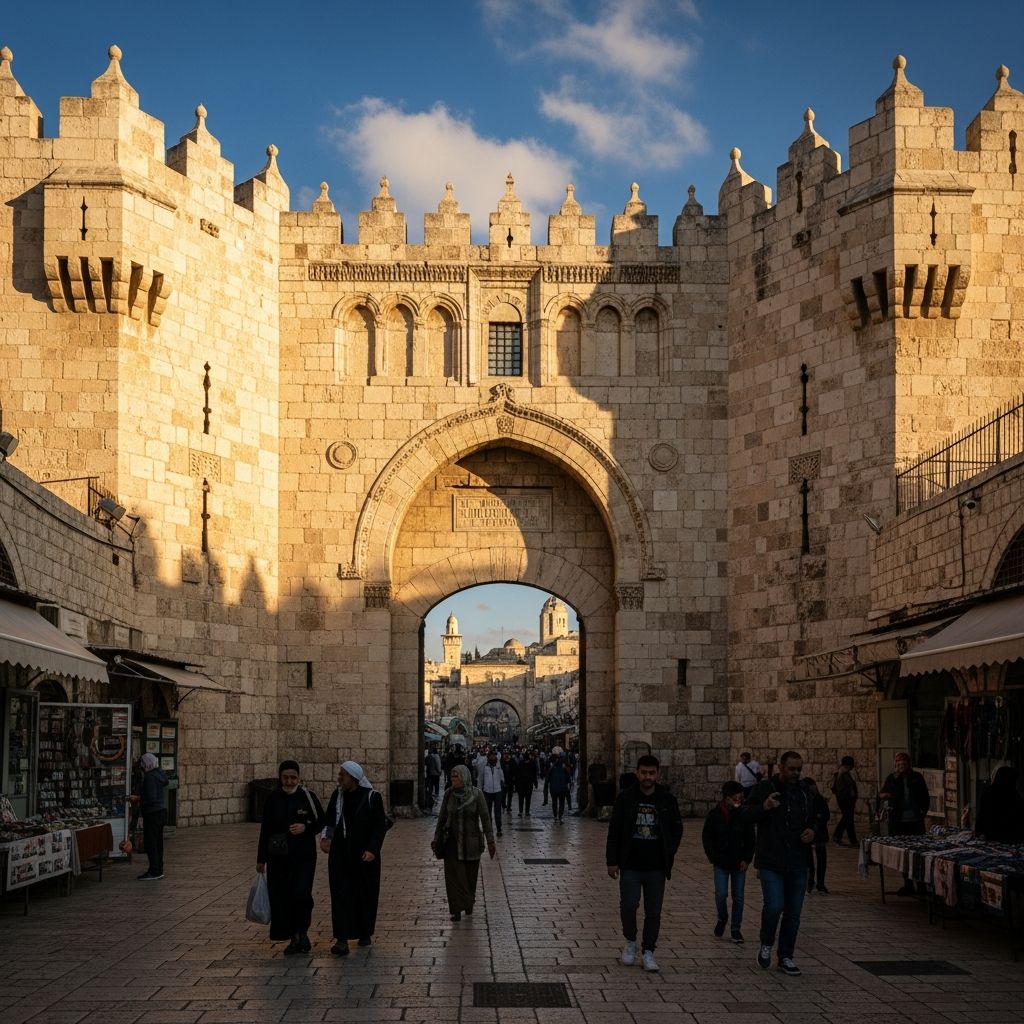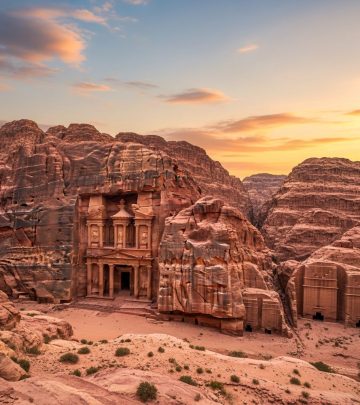Damascus Gate: The Iconic Northern Entrance to Jerusalem’s Old City
An iconic blend of history, architecture, and vibrant life at Jerusalem’s renowned Damascus Gate.

Damascus Gate: A Timeless Portal into Jerusalem’s Old City
Damascus Gate stands as one of the defining landmarks of Jerusalem’s Old City—a monumental entrance blending layers of history, extraordinary architecture, and daily vibrancy. Known in Arabic as Bab al-Amud (Gate of the Column) and in Hebrew as Sha’ar Shechem (Shechem Gate), this gate is celebrated not only for its age and architectural grandeur, but for its ongoing role as the busiest and most storied entry into the heart of Jerusalem.
Whether approached from the bustling modern city or from the timeless souks within, Damascus Gate is a living testament to centuries of religious, cultural, and urban evolution.
Key Facts About Damascus Gate
- Location: Northern wall of Jerusalem’s Old City, facing the modern city’s Nablus Road.
- First Construction: Roman period, rebuilt and expanded in later eras.
- Current Form: Ottoman, 16th century (Suleiman the Magnificent, 1537 CE).
- Primary Function: Main entrance to the Muslim Quarter and northern markets.
- Current Names: Bab al-Amud (Arabic), Sha’ar Shechem (Hebrew), Damascus Gate (English).
History: Layers of Civilizations
The story of Damascus Gate embodies the chronicles of Jerusalem itself—each era imprinting its ambitions on the stones of this remarkable gateway.
The Roman Era
The first monumental gate at this site was erected in the 2nd century CE. Historical accounts trace its origins to the reign of Herod Agrippa I (41 CE), later rebuilt under the Roman Emperor Hadrian when the city was refounded as Aelia Capitolina around 135 CE. The Roman gateway was far more than a functional portal—it was a symbol of imperial vision, marked by a triumphal arch with three imposing arches. A prominent Roman column once stood just inside the gate, serving as a city center point and the origin of the Arabic name, Bab al-Amud (Gate of the Column).
Byzantine and Early Muslim Periods
The shape and function of the gateway evolved through the Byzantine era and after the city’s conquest by Muslim forces in the 7th century. The structure was progressively modified but retained its role as a principal entrance. Traditions associated with Christian pilgrimage and early Islamic governance left their marks, but the gate’s essential place in monumental city planning remained constant.
Crusader and Ayyubid Transformations
When the Crusaders seized Jerusalem in the 12th century, Damascus Gate was heavily fortified. Towers, additional defensive walls, and an outer “barbican” (outer gatehouse) were constructed. The Crusaders referred to the gate as St. Stephen’s Gate (Latin: Porta Sancti Stephani), due to its proximity to the traditional site of the martyrdom of Saint Stephen. Over subsequent centuries—particularly during the Ayyubid and second Crusader reigns—further modifications ensued, although much of this outer barbican was destroyed in the early 13th century.
The Ottoman Rebuilding: Sixteenth Century
The structure seen today was largely the creation of Ottoman Sultan Suleiman the Magnificent, who, in 1537, ordered the reconstruction of Jerusalem’s walls and principal gates. The resulting Damascus Gate showcases signature Ottoman military and decorative architecture, combining functionality with elaborate symbolic flourishes. Its facade, with robust towers and stone ornamentation, provided both defense and a grand statement of imperial authority.
Modern Era and Preservation
Damascus Gate has continuously witnessed the city’s evolving demography, trade patterns, and geopolitical shifts. During the British Mandate and after the events of the Six-Day War (1967), the gate underwent restoration, including the rebuilding of its crenellated turret, which had been severely damaged. Archaeological excavations in the 19th and 20th centuries laid bare the Roman foundations beneath the Ottoman stonework, unveiling centuries of layered construction.
Architectural Features
Damascus Gate’s architectural brilliance is a fusion of military ingenuity and ceremonial grandeur. Its imposing presence is both visually dramatic and practical—conveying security, prestige, and urban connectivity.
- Arched Main Entrance: Strategically recessed behind a broad staircase, the gate’s primary entrance is pronounced by a high, pointed Ottoman arch, crowning the entryway with a majestic flourish.
- Towers and Battlements: The gate is flanked by two substantial square towers, each featuring machicolations (stone projections with openings from which defenders could drop projectiles). Along the parapets are distinctly Ottoman triangular crenellations, creating a crown-like silhouette.
- Forecourt: Approaching from the north, visitors step down a wide set of stairs into an open plaza before entering the gate—a design contrasting with the rising stairs of other gates like Jaffa Gate. This staged procession accentuates the gate’s prominence and enhances crowd movement.
- Inner Passage: Beyond the gate lies a broad vaulted corridor, adorned with pointed arches and smooth stonework typical of Ottoman style. This interior once hosted the customs and security functions of the city.
- Roman Foundations: Below the present gate, remnants of the earlier Roman gate, including parts of the original columns and arches, are visible in certain areas—testifying to the site’s deeper antiquity.
Other notable features include the crenellated turret (restored after 2011 based on historic photographs), strategic arrow slits, and strong portal doors. The plaza outside the gate was historically the site where caravans gathered and markets thrived, making Damascus Gate not just an entrance, but a hub for commerce and social life.
Names Through the Ages: Significance and Symbolism
Damascus Gate carries a trio of historic names, each reflecting a facet of its long and varied identity:
- Bab al-Amud (Arabic: “Gate of the Column”): This name has endured since at least the 10th century and references the Roman column that once stood just inside the entrance, serving as the city’s central kilometer marker and point for architectural orientation.
- Sha’ar Shechem (Hebrew: “Shechem Gate”): Named for the ancient road leading northward to Shechem (modern-day Nablus).
- Damascus Gate (English): So named because the principal road through the gate headed northwards to Damascus, highlighting its strategic and commercial role as Jerusalem’s northern portal.
- St. Stephen’s Gate (Crusader Era): The Crusaders endowed it with this name due to the veneration of nearby Christian holy sites.
The constancy of Bab al-Amud as the Arabic term for the gate sets it apart from other city entrances, whose names have shifted more fluidly over time.
Cultural and Urban Significance
Damascus Gate has long been more than a defensive structure; it is a bustling urban theatre where the city’s social, political, and economic energies converge.
- Main Portal for Markets: For centuries, merchants, pilgrims, and locals have streamed through Damascus Gate. Just beyond the entrance is El-Wad Street (“Valley Street”), one of the main arteries of the Old City’s Muslim Quarter, leading to the vibrant souks (markets) teeming with goods and stories.
- Cultural Exchange: The gate is cited by UNESCO among elements of Jerusalem bearing “an important interchange of human values, over a span of time or within a cultural area of the world, on developments in architecture, technology, and the arts”.
- Community Focal Point: The forecourt remains a gathering place for community events, political demonstrations, and daily life—a crossroads for the city’s diverse populations.
- Symbol of Identity: For many Jerusalemites, especially in the Palestinian community, Damascus Gate is not only a portal but a symbol of historical presence and resilience, often featuring in literature, art, and popular memory.
| Period | Gate Name | Main Function |
|---|---|---|
| Roman | Bab al-Amud | Triumphal entrance, city center marker |
| Byzantine/Muslim | Bab al-Amud / Shechem Gate | Principal city entrance |
| Crusader | St. Stephen’s Gate | Fortified entry, access to Christian sites |
| Ottoman | Bab al-Amud / Damascus Gate | Main marketplace entrance, urban security |
Damascus Gate Today: Security, Preservation, and Living Heritage
Damascus Gate remains an epicenter of movement, commerce, and at times, political tension. While the flow of daily life continues, the area around the gate is closely monitored with security infrastructure—watchtowers, detectors, and other controls—implemented by municipal authorities, especially given the gate’s symbolic visibility and history of demonstrations.
- Tourism: The gate is one of the top stops for visitors interested in exploring the Old City, serving as both practical entry and a photographic highlight.
- Restorations: Ongoing preservation efforts seek to maintain Damascus Gate’s architectural integrity while providing for modern urban needs. Notably, the British Mandate period saw structural repairs, and after the Six-Day War, significant restorations were made to maintain its historic profile.
- Vibrant Hub: Markets, food vendors, and spontaneous performances offer a constant pulse of local life, making the gate a primary venue for experiencing the rhythms of Jerusalem’s Old City.
Visiting Damascus Gate: What to Expect
For those entering the Old City today, Damascus Gate is not just a relic of the past but a threshold into the living heart of Jerusalem’s Muslim Quarter. Upon passing through the imposing boundary, visitors are immediately immersed in a sea of market stalls, aromatic spices, traditional textiles, and the timeless rhythm of communal interaction.
- Getting There: Damascus Gate is easily accessible by foot, local bus, or light rail from central Jerusalem. Its central plaza is often buzzing with both locals and tourists.
- What to See: Explore the distinctive Ottoman arches, towers, and stonework as you descend the wide steps. Don’t miss the views across the modern northern cityscape and the energetic street life at the gate’s threshold.
- Nearby Attractions: Inside, follow El-Wad Street southwards to encounter the vibrant Muslim Quarter and onward toward the Christian and Jewish Quarters. Outside, the immediate area features cafes, street vendors, and access to traditional neighborhoods.
- Visitor Tips: Mornings and late afternoons offer the liveliest atmosphere; however, the area can become crowded during holidays and religious events.
Frequently Asked Questions (FAQs)
Q: Why is Damascus Gate named so?
A: The English name “Damascus Gate” reflects the ancient road leading northward to the city of Damascus, while the Arabic name “Bab al-Amud” refers to the Roman column that stood near the entrance.
Q: Who built the current structure of Damascus Gate?
A: The present gate was constructed in 1537 CE during the reign of Ottoman Sultan Suleiman the Magnificent. However, foundations from the Roman period (2nd century CE) are still visible beneath the existing structure.
Q: What is distinctive about the architecture of Damascus Gate?
A: The gate is known for its pointed Ottoman arch, twin towers with defensive machicolations, restored crenellated turret, descending staircase, and the visibility of the older Roman gate below the present portal.
Q: What markets or sites can be accessed via Damascus Gate?
A: Immediately inside Damascus Gate is El-Wad Street, which leads into the bustling Muslim Quarter, famous for its bazaars, as well as to several important religious and historical sites within Jerusalem’s Old City.
Q: Can visitors still see remnants of the ancient gates at the site?
A: Yes, archaeological remains of the original Roman gateway, including sections of arches and columns, can be seen beneath or near the present Ottoman structure.
Related Points of Interest
- Zedekiah’s Cave: Also known as Solomon’s Quarries, located just east of Damascus Gate, this massive underground cavern dates back to antiquity and is open to visitors.
- Other City Gates: Jerusalem’s Old City is encircled by several historic gates—including Jaffa Gate (western entrance), Lions’ Gate (northeast), and Herod’s Gate (north)—each with its own story and characteristics.
The Enduring Legacy of Damascus Gate
In every stone and every bustling encounter at its threshold, Damascus Gate illustrates the dynamic fusion of Jerusalem’s heritage and present life. An architectural marvel and a symbol of perseverance, it welcomes millions each year—bearing witness to all who enter the endlessly fascinating Old City.












